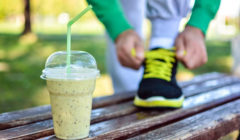Eat According to Your Activity Level
Most of us have heard the phrase “Eat According to Your Activity Level,” but what EXACTLY does that mean? This can be a bit misleading because some of us need more calories than others and there are so many factors to take into consideration.
 We need to look at food as fuel! Food serves as an energy source to keep us going throughout the day. Our bodies burn calories doing normal daily activities, such as, breathing, sweating, sleeping and sitting. Doing extra activities like biking, running, hiking, weight lifting, dancing, etc. burns extra calories. However, it’s common that a person will over estimate how many calories they burned and subsequently overshoot how many calories they actually need.
We need to look at food as fuel! Food serves as an energy source to keep us going throughout the day. Our bodies burn calories doing normal daily activities, such as, breathing, sweating, sleeping and sitting. Doing extra activities like biking, running, hiking, weight lifting, dancing, etc. burns extra calories. However, it’s common that a person will over estimate how many calories they burned and subsequently overshoot how many calories they actually need.
If you’re thinking, “I jogged 20 minutes on the treadmill, I can afford to eat that ice cream after dinner,” think again. A 20-minute jog may burn around 180-200 calories, depending how fast you are jogging. That bowl of ice cream can add up to over 300 calories. Essentially, the calories you burned were put right back into your body – plus a few more.
Tracking Your Food and Calorie Intake
Research shows that people who log calories lose more weight and are more likely to keep the weight off in the long run. These days, counting calories is very easy. There are many useful websites and apps that help you log your meals and track your progress.
One of my favorites is MyFitnessPal. It tracks your weight and calculates a recommended daily calorie intake. It also contains a well-designed food diary and an exercise log. The homepage provides a clear picture of how many calories you’ve consumed (with a breakdown of carbs, proteins and fat) during the day. In addition, it shows your remaining recommended intake and the number of calories you’ve burned by exercising.
What is Energy Balance?
Energy is another word for “calories.” Your energy balance is the balance of calories consumed through eating and drinking compared to calories burned through physical activity. What you eat and drink is ENERGY IN. What you burn through physical activity is ENERGY OUT.
You burn a certain number of calories just by breathing air and digesting food. You also burn a certain number of calories (ENERGY OUT) through your daily routine.
Eating just 150 calories more a day than you burn can lead to an extra 5 pounds over 6 months. That’s a gain of 10 pounds a year. Frightening, isn’t it?
How Many Calories Should You Eat?
In dietary terms, calories are the amount of energy that a food provides. The definition of a calorie is the amount of energy needed to raise the temperature of 1 gram (g) of water through 1° Celsius.
The type and amount of food we eat determine how many calories we consume. How and when we eat can also make a difference, as the body uses energy differently throughout the day. Our body’s energy use will depend on how active we are, how efficiently our body uses the energy, and our age.
According to the 2015-2020 Dietary Guidelines for Americans, women are likely to need between 1,600 and 2,400 calories a day, and men from 2,000 to 3,000. However, this depends on their age, size, height, lifestyle, overall health, and activity level.
Food Choice
Keeping calorie intake within certain limits will not ensure you are eating a healthy diet, as different foods have different effects on the body.
After consuming carbohydrates, insulin levels will rise significantly more compared with eating fats or protein. Some carbs in particular get into the bloodstream in the form of sugar, or glucose, much faster than others.
Refined flour is a fast carb, while legumes are slower. Slow-release carbs are better for body weight control and overall health than fast carbs.
A 500-calorie meal of fish, a salad, and some olive oil, followed by fruit, is healthier and will keep you satisfied much longer than a 500-calorie snack with no nutritional value.
To work out how many calories you need, you need to know your basal metabolic rate and an activity factor.
Basal metabolic rate
One useful way of estimating BMR is the Mifflin-St. Jeor equation:
Men: 10 x weight (kg) + 6.25 x height (cm) – 5 x age (y) + 5
Women: 10 x weight (kg) + 6.25 x height (cm) – 5 x age (y) – 161
Activity factor
After calculating the BMR, multiply the result with an activity factor:
• Sedentary lifestyle: If you do very little or no exercise at all, your daily calorie requirement is BMR x 1.2.
• Slightly active lifestyle: If you do light exercise between one and three times a week, your daily calorie requirement is BMR x 1.375.
• Moderately active lifestyle: If you do moderate exercise three to five times a week, your daily calorie requirement is BMR x 1.55.
• Active lifestyle: If you do intensive exercise six to seven times per week, your daily calorie requirement is BMR x 1.725.
• Very active lifestyle: If you do very intensive exercise twice a day, with extra heavy workouts, your daily calorie requirement is BMR x 1.9.
This will give a rough idea of the daily calorie intake you need to keep your body weight where it is. The result is still not perfect, as the equation does not take into account the ratio of muscle to fat. A very muscular person needs more calories, even when resting.

Ideal body weight
As with calories requirements, an ideal body weight depends on several factors, including age, sex, bone density, muscle-fat ratio, and height.
Waist-hip ratio
Researchers have found that many people whose waist circumference is less than half their height have a longer life expectancy.
People with a smaller waist to height size have been found to have a lower risk of diabetes, cardiovascular disease, stroke, and other health conditions that are related to obesity.
An adult male who is 6 feet (183 cm) tall should have a waist that does not exceed 36 inches (91 cm).
An adult female who is 5 feet 4 inches (163 cm) tall should have a waist that does not exceed 32 inches (81 cm).
To measure the waist, measure half-way between the lower rib and the pelvic bone at the hip.
In Conclusion:
Remember, counting calories is not just a matter of what we eat, but how much we burn, too. More important than counting calories is to eat a well-balanced diet that you can sustain long-term!
Stay physically active and balance calories according to your activity level. Do your best to make healthy lifestyle choices and I promise you will be a huge success. Good luck to you!

Baked chicken breasts with lemon, white rice and green spinach and cucumber salad











